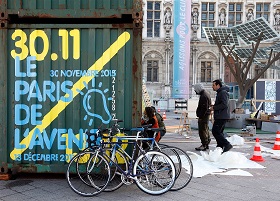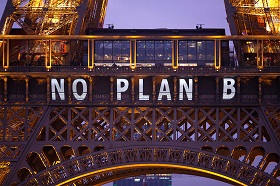Global Action against Climate Change: Time to Join Forces
(no votes) |
(0 votes) |
PhD in Political Science, RIAC Expert
When the 21st Conference on Climate Change in Paris (COP21) and the 11th Conference of the Parties to the Kyoto Protocol held from November 30 to December 11 last year approved the new comprehensive agreement covering the time period up until 2020 in international cooperation on climate, it became clear that states have come to the understanding that urgent action is needed to reduce climate change-related threats and stabilize concentrations of greenhouse gases.
Combating climate change is one of the seventeen goals in the Agenda for Sustainable Development adopted by the United Nations Sustainable Development Summit in September 2015 [1].
When the 21st Conference on Climate Change in Paris (COP21) and the 11th Conference of the Parties to the Kyoto Protocol held from November 30 to December 11 last year approved the new comprehensive agreement [2] covering the time period up until 2020 in international cooperation on climate, it became clear that states have come to the understanding that urgent action is needed to reduce climate change-related threats and stabilize concentrations of greenhouse gases (GHG).
As the depositary of the Paris Agreement, the UN Secretary General invited the world leaders to the next April 22 opening ceremony for the signing of the Agreement at the United Nations headquarters in New York [3], with the signing period lasting until April 21, 2017. Symbolically, the UN has proclaimed April 22 as international Mother Earth Day [4]. To become effective, the document must be ratified but at least 55 countries that jointly emit at least 55 percent of the GHGs.
The Kyoto Protocol as a Pilot Project
As of now, international efforts to cut manmade discharges of greenhouse gases are coordinated by the Kyoto Protocol [5], which was adopted to augment the UN Framework Convention on Climate Change in December 1997 and came into force on February 16, 2005 after being ratified by Russia. Stage one of the Protocol implementation lasted from January 1, 2008 to December 31, 2012.
For its time, the Kyoto Protocol was a major advance in international cooperation on climate protection as it legally committed nations to work to prevent hazardous human- generated impacts on the climatic system. Moreover, it has become the first international legal instrument to engage market tools for handling ecological problems. The Protocol also specified the obligations for reducing GHG emissions and relevant time periods, also setting quantitative parameters for the discharge cuts to be reached by industrialized countries.
Quantitative levels were established only for those listed in Appendix B to the Kyoto Protocol, which covered most of the industrialized and emerging economies, but not developing countries. Limits were intended to bring down the aggregate level of emissions for six gases (carbon dioxide, methane, fluorohydrocarbons, fluorocarbons, nitrous oxide, and sulfur hexafluoride) by at least five percent against the 1990 basic level (see Kyoto Protocol, Article 3, Para 1).
The European Union was obliged to cut emissions by eight percent, the United States – by seven percent, Japan and Canada – by six percent, East European and Baltic states – by eight percent on average, while Russia was obliged to preserve mean annual emissions in 2008-2012 at the 1990 level (zero growth).
Global efforts to alleviate manmade pressures on the climate system have been emaciated by the fact that China, the United States and India, the three of the five largest polluters, refused to make similar obligations. The U.S. signed the Kyoto Protocol but did not ratify it, complicating the process of its coming into force.
According to UN experts, by 2012 the Protocol participants cut GHG emissions by more than 20 percent, by far exceeding the five-percent goal [6].
Post Kyoto
According to Para 9 Article 3 of the Kyoto Protocol, talks on setting the commitments of the parties under Appendix B, i.e. industrialized countries, for the upcoming periods were to be started at least seven years before the expiration of the initial period of 2008-2012, which means in 2005.
However, due to major tensions related to the refusal of Washington to participate in the Protocol, implementation problems on the part of leading industrialized states and unwillingness of large emitters among developing nations to take up obligations for the upcoming stages, the world community until last year could not reach mutually acceptable solutions for the post-Kyoto period.
Intrigue actually remained until the closing hours of the COP18 event in late 2012 Doha, which was extended by 24 hours.
The key outcome in Doha happened to be in the decisions that launched the process for the development of a new legal document to replace the Kyoto Protocol (the preparation of the draft by 2015 and its coming into effect in 2020), as well as a package of practical recommendations for the subjects and timetable of the negotiations.
As for the Kyoto Protocol’s second stage (2013-2020) launched by the Doha decisions, taking into account its participation, it covers only 13-14 percent of total GHG emissions, which considerably limits its practical importance. Japan and New Zealand joined Russia in refusing the second stage obligations, with the United States still staying out of the Protocol and Canada leaving in December 2011.
Kyoto-2 obligations were assumed only by the EU countries, Australia, Kazakhstan, Ukraine, Belarus, Norway, Switzerland, Iceland, Lichtenstein and Monaco.
According to the Doha Amendment (the entire package of amendments to the Kyoto Protocol for stage two is seen as a single amendment), each party to the Protocol with the second-stage commitments was to assess its level of commitments in 2014 at the latest and present information for a possible increase before April 30.
Commitments for industrialized countries under Kyoto-1 covered only 30 percent of global GHG emissions, while at stage two the figure was halved. Hence, Kyoto-2 was a step back in terms of protecting global environment from harmful effects. This approach appears insufficient for reaching the internationally agreed goal of limiting the rise of global temperature by two degrees Celsius [7].
Obligations of Key GHG Emitters
As had been prescribed by the COP19 in Warsaw on November 11-22, 2013 and COP20 in Lima on December 1-12, 2014, each party was to present its share within the process titled Intended Nationally Determined Contributions. Industrialized states including the European Union were supposed to make their programs public by March 31, 2015, while for the developing countries, the deadline was set for the fall of the same year.
Especially important for reaching a consensus for a comprehensive agreement to cover the period after 2020 was the joint statement on climate change signed by Xi Jinping and Barack Obama on November 12, 2014 on the margins of APEC [8]. As a matter of fact, their aggregate GHG discharge exceeds 40 percent of the global volume.
The United States pledged to cut its emissions by 26-28 percent by 2025 compared to 2005 when the Kyoto Protocol became effective.

Yulia Yamineva:
UN Summit on Climate Change in Paris –
Destined to Fail or Succeed?
In its turn, China is going to peak its GHG emissions by 2030 or earlier and increase the share of renewable sources in the national energy consumption structure to 20 percent. As a new element of the climate deal, Beijing stated its readiness to cut its emissions by 60-65 percent per unit of GDP by 2030 compared to 2005 [9].
In the context of the Sino-American accords, India, the world's third largest polluter, could hardly stand aside and pledged to reduce emissions by 33-35 percent by 2030 compared to 2005 [10].
In view of its role in the international climate process and importance of consolidating the global consensus on climate within the transitional period, i.e. from the Kyoto stages one and two to the new comprehensive agreement, Russia has set its national goal for cutting the GHG emissions to 25 percent by 2020 against 1990.
In Paris, the Russian delegation presented the parameters of its intended national commitments within a new climate agreement – limiting manmade GHG emissions at 70 percent against 1990 with maximum consideration given to forests and their significance for alleviating climate change consequences and adaptation to these processes [11].
On the whole, Russia is implementing diverse measures within national programs, legislative and normative acts, as well as administrative procedures designed to better handle the climate problem. The range of adopted documents includes the Russian Federation Climate Doctrine of 2009 [12] and Comprehensive Action Plan for its implementation of June 4, 2008 No. 889 "On Measures for Raising the Energy and Ecology-Related Efficiency of the Russian Economy" [13] , Federal Law 261-FZ of November 23, 2009 "On Energy Saving and Raising Energy Efficiency" [14] , "Energy Strategy of Russia until 2030" (approved by Executive Order of the Russian Federation Government No. 1715-r of November 13, 2009) [15] , as well as Executive Order of the Russia Federation President "On Reduction of Greenhouse Gases Emissions" No. 752 of September 30, 2013 [16].
In order to attract public attention to the ecological development of Russia, preservation of biodiversity and ecological security, on January 5, 2016 President Vladimir Putin signed Executive Order "On the Ecology Year in 2017 in the Russian Federation." [17]
These measures are intended to reduce the cumulative GHG emissions in 1990-2020 by over 30 billion tons in the carbon dioxide equivalent. By reaching these high levels, Russia will considerably contribute to global efforts aimed at reducing human-inflicted pressures on the climate system of the Earth.
Japan, the fifth largest emitter, on July 17, 2015 pledged cutting emissions by 25.4 percent by 2030 compared to 2005 (26 percent as compared to 2013), which would constitute 1.04 billion tons in the carbon dioxide equivalent [18].
This process was traditionally led by the EU which used its summit on October 23-24, 2014 in Brussels to adopt an ambitious program and reach a collective reduction threshold by 2030 by 2030 and by 80-95 percent by 2050, as well as to raise the share of renewable sources in its energy balance to 27 percent by 2030 against 1990 [19].
Previously, the EU countries had sufficed with more modest figures, i.e. cutting emissions by 20 percent by 2020 and by 50 percent by 2050, bringing its renewable energy share to 20 percent by 2020 [20].
Noticeably, at the Paris conference Chancellor Angela Merkel boasted reaching the 27-percent level of renewable sources in the German energy balance [21]. Moreover, the Renewable Energy Law was edited in 2014 to raise the share of renewable sources up to 40-45 percent by 2025 and to 55-60 percent by 2035. By 2050, Berlin plans to obtain a minimum of 80 percent of electric power from renewable outlets [22], which also implies significant economic and political consequences, in no small measure in view of achieving energy independence from other countries including Russia.
Version 2.0: Reset

RIAC Digest
The Paris Agreement is based on the principles of the common although differentiated responsibility and incorporates the elements of a global strategy for alleviating climate-targeted impacts, primarily through reducing GHG emissions. A key goal of the document lies in the recognition of the need for containing the increase of the global mean temperature considerably under two degrees Celsius above pre-industrial levels (1990), as well as efforts to limit the rise in temperature to 1.5 degrees Celsius. Differentiated responsibility is expressed by the legitimized right of the developing world to advance slower than the industrialized nations.
Industrialized states have been called on to begin amassing funds in 2020 in the amount of at least USD 100 billion annually and transfer technologies to assist developing countries in their efforts to curb global warming. After 2025, this sum should be increased to meet their growing needs and priorities. The distribution of these funds should be taken up by the Green Climate Fund set up by the UN in 2010. However, this decision prescribed by the Paris Agreement has not been supported by clear-cut distribution mechanisms and obligations of the industrialized nations.
During the Paris Conference, new contributions were pledged by France, which is ready to raise its annual input from three to five billion dollars, as well as by Spain, Germany and Canada. The World Bank undertook to bring up its share to USD 16 billion by 2020 [23].
Russia has spectacularly augmented the Paris Agreement with the text on the key role on forests (Article 5) in absorption of greenhouse gases, which has been vital for Moscow in view of its input in fulfilling obligations for cutting anthropogenic emissions, since the area of Russian forests makes about 8.5 million square kilometers [24].
Under the Paris Agreement, a special task force will be soon formed to prepare for the document to come into effect, which will be followed by work on ratification. The document will become effective after ratification by 55 states emitting about 55 percent of global GHGs.
The new agreement is legally binding but contains no specific goals for decreasing emissions that are listed in a special UN register. To restrict the rise in the Earth’s temperature, all countries will have to develop long-term strategies for low-carbon development, with the initial report to be presented in 2022, as well as present plans for adjusting to climate change. This approach opens a way to have the document ratified by the United States through a direct presidential signature bypassing Senate.
The Paris Agreement also creates a new international instrument to replace the clean development mechanism and joint projects of the Kyoto Protocol era. The new sustainable development arrangement allows countries to finance projects on reducing emissions in other countries without the differentiation between industrialized and developing members. However, in contrast to the Kyoto Protocol that distributed the GHG emission quotas between industrialized countries and allowed direct trading and financing discharge reduction in other countries, the new mechanism will not be openly market-oriented. In fact, the reduction of emissions will be combined with sustainable economic development taking into account socio-ecological aspects.
The fulfillment of the Paris Agreement and relevant obligations of the parties appears increasingly urgent because of the noticeable accumulation of harmful climatic manifestations in recent years, among them natural disasters, glacier melting, etc., while the causes include higher reliability of scientific hypotheses proving the dependence of the climate change on manmade GHG emissions, the rising role of the climate change in international security, accumulating economic damage caused by climatic effects, and the proneness of key states to decrease the energy and carbon consumption of their economies (GHG emissions per GDP unit) due to energy shortage.
The member countries are in for difficult and painstaking work within the UN framework to make a future climate-related cooperation regime exceptionally effective and reflect the current realities and interests of the entire global community.
1. /inner/?id_4=6574#top-content
2. http://unfccc.int/resource/docs/2015/cop21/rus/l09r01r.pdf
3. http://www.un.org/russian/news/story.asp?newsID=25101
4. http://www.un.org/ru/events/motherearthday/
5. http://www.un.org/ru/documents/decl_conv/conventions/pdf/kyoto.pdf
6. http://www.un.org/russian/news/story.asp?NewsID=23200#.VpMJfU8pldg
7. https://interaffairs.ru/jauthor/material/833v
8. https://www.whitehouse.gov/the-press-office/2014/11/11/us-china-joint-announcement-climate-change
9. http://www.reuters.com/article/us-france-china-climatechange-idUSKCN0
PA1G42015063010. http://www4.unfccc.int/submissions/INDC/Published%20Documents/India/1/
INDIA%20INDC%20TO%20UNFCCC.pdf11. http://kremlin.ru/events/administration/50794
12. http://kremlin.ru/events/president/news/6365
13. http://www.rg.ru/2008/06/07/ukaz-dok.html
14. http://www.rg.ru/2009/11/27/energo-dok.html
15. http://www.minenergo.samregion.ru/norm_base/fed_norm_base/NPA_fed_energo/
16. http://kremlin.ru/acts/bank/37646
17. http://kremlin.ru/events/president/news/51142
18. http://www4.unfccc.int/submissions/INDC/Published%20Documents/Japan/1/
20150717_Japan's%20INDC.pdf19. http://www.consilium.europa.eu/uedocs/cms_data/docs/pressdata/en/ec/145397.pdf
20. http://observer.materik.ru/observer/N5_2010/110_114.pdf
21. http://www.bundesregierung.de/Content/DE/Rede/2015/11/2015-11-30-bkin-cop21.html
22. http://www.erneuerbare-energien.de/EE/Redaktion/DE/Gesetze-Verordnungen/
eeg_2014.pdf?__blob=publicationFile&v=7
(no votes) |
(0 votes) |





